March 2nd, 2016
Laser Focused
The Creative Embrace of Programmatic
Programmatic Media, or simply programmatic, is heralded as a sea of change in how we will market, not just in the future, but now. Narrowly focused, programmatic refers to the automation of media buys and placements, and one could simply think of this as a logistics improvement. If you’ve used Facebook’s or Google’s advertising tools, you are already familiar with the surgical precision that such a toolset can afford you.
 Programmatic takes targeting and content customization precision and breaks it from any specific platform, extending it to the entirety of your advertising campaign. We’re used to using data to smartly place an ad. What if we used that same data to dynamically deliver an ad that is customized to the viewer? In a world where ads can be tailored to demographics in real time (and across screens) the creative possibilities are endless.
Programmatic takes targeting and content customization precision and breaks it from any specific platform, extending it to the entirety of your advertising campaign. We’re used to using data to smartly place an ad. What if we used that same data to dynamically deliver an ad that is customized to the viewer? In a world where ads can be tailored to demographics in real time (and across screens) the creative possibilities are endless.
I don’t blame you if your head is spinning with possibilities surrounding these emerging capabilities. As we move into the era of programmatic media, here are three key areas to focus your creativity on as we enter a new age of advertising:
1. Agility
Real time works both ways – with easy placement comes easy feedback. Traditionally, one might wait for a month of results and react accordingly. Programmatic offers us the luxury of seeing how individual ads are performing, as well as the ability to adjust copy and imagery to alternate content immediately. We can even run it alongside the existing media to assess the impact on results.
2. Context
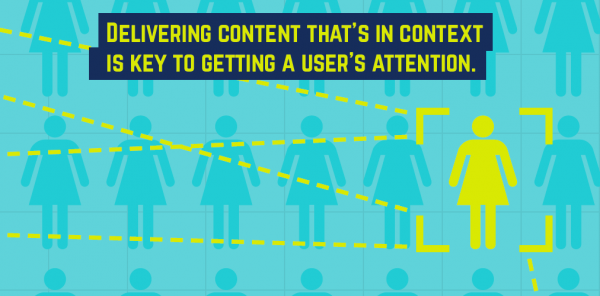 Storytelling is a key element of advertising campaigns and works great in traditional media. In the digital world, a user’s focus is often divided, and you usually won’t have their captive attention for more than 15 seconds or so. Designing and delivering content that’s in context is key to getting a user’s attention. Rather than trying to tell the whole story in one place, embrace the idea that your audience will see your message on many mediums and focus on being relevant to the user
Storytelling is a key element of advertising campaigns and works great in traditional media. In the digital world, a user’s focus is often divided, and you usually won’t have their captive attention for more than 15 seconds or so. Designing and delivering content that’s in context is key to getting a user’s attention. Rather than trying to tell the whole story in one place, embrace the idea that your audience will see your message on many mediums and focus on being relevant to the user
at that in-context moment.
3. Targeting
Advertising to the broad 18-49 demographic is a thing of the past, but only if you’re willing for it to be (as are straightforward notions like re-targeting a user who previously viewed your content). Programmatic offers nuanced potentials, such as targeting a competitor’s customers or even targeting your existing customers for a cross-sell opportunity. An agile and context-aware approach to your marketing will work especially well as programmatic assists you in honing your existing markets and showing you new opportunities.
Because the modern person consumes content across many screens, and often in tandem, our marketing will benefit by adapting to this reality with an omni-channel experience 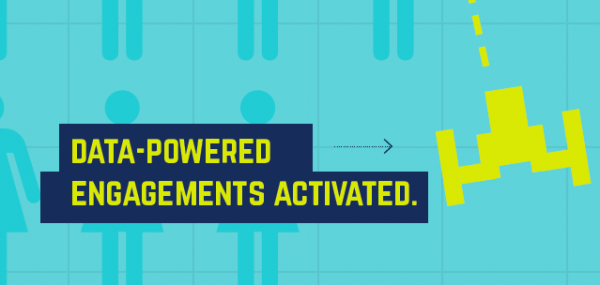 throughout campaigns. Programmatic is a quickly growing tool we can use to unify consumer experiences and unleash new data-powered engagements that previously were never possible.
throughout campaigns. Programmatic is a quickly growing tool we can use to unify consumer experiences and unleash new data-powered engagements that previously were never possible.
March 2nd, 2016
Screen Surfing
How Generations View TV Differently
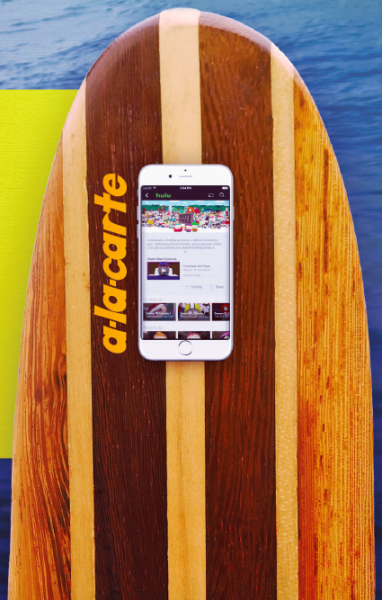 TV is currently the leader in traditional advertising – that’s no secret. But just what do consumers think is in store for television and TV advertising? Will TV remain the leader? Is it already losing ground?
TV is currently the leader in traditional advertising – that’s no secret. But just what do consumers think is in store for television and TV advertising? Will TV remain the leader? Is it already losing ground?
To try and gain a broader perspective on the topic, I interviewed a range of generations. I asked three 20-year-olds, three 40-year-olds and three 60-year-olds questions. What I hoped to find was some deeper insight into each individual demographic (as much as one can when interviewing three people to represent an entire generation), but what I ended up getting was more of a unique view on the psyche and watching-habits of the average 20-year-old. As well as where the entire group thinks TV will be in 10 years.
Here are a few of the more interesting things I discovered.
60-year-olds watch twice as much TV as 20-year-olds.
20-year-olds: They all said they watch about 2 hours per day.
40-year-olds: They all said they watch between 2-4 hours per day.
60-year-olds: They all said they watch between 6-8 hours per day.
While 20-year-olds don’t often watch TV, when they do, they do so online.
Melanie: “I spend a lot less time watching TV and more time watching via another screen, whether it’s my laptop or my iPad or even my phone.”
Taylor: “I have friends who are not even purchasing cable for their apartments.”
Collin: “TV is something that can be done without.
I mainly would just watch TV for the news and then everything else I can get off of Netflix or something else.”
Two of the 20-year-olds think that the next generation doesn’t have the same sense of family bonding.
Melanie: “Many of the kids I babysit prefer to watch shows and movies on their iPads. They don’t have to compromise on a movie. I hate this and love that TVs can be family bonding, like watching a movie together.”
Taylor: “Before we had DVR, I remember my parents planning dinner and other things around TV, like having to eat and clean the kitchen before West Wing or Survivor came on. It was so important to them that we spent that time watching together as a family.”
When asking the question, “Where do you see TV in the next 10 years?”, I got similar answers across the board.
20-year-olds
Melanie: “People will move toward transportable means, such as a tablet or a laptop.”
Taylor: “Traditional TV will be gone.”
Collin: “I think they’re going to do away with cable providers and it’ll be more or less like a subscription service, like on Apple TV. And I can pretty much buy just certain channels.”
40-year-olds
Jeremy: “Sports programming is going to continue to change the landscape of TV. That’s the only thing people want to watch live. The rest of our programming is going to have to adapt to
a-la-carte watching.”
Eric: “Hopefully we’ll have something more affordable for people other than dish or cable – like a pay-by-channel system. I see more people going away
from TV and onto other things like Netflix, etc.”
Stacy: “I think it’s going to go to more streaming. More and more people are getting rid of contracts. You can go onto Amazon, Netflix, Hulu. It’s more affordable.”
60-year-olds
Dennis: “There are going to be more channels catered to what you want. And you can get the price down based on what you want to watch.”
Sue: “Everything will be combined – Internet, TV and telephone. I anticipate that TV will become more interactive with the viewer.”
Carolyn: “It’ll all go to paid-for channels.”
All in all, I think it’s safe to say that TV is changing with every new generation. Obviously. But just this tiny glimpse into the opinions of these generations tells me that a big shift in the way people buy and watch television is probably coming sooner than later. Question now is, how will marketers adapt?
February 12th, 2016
Strategy
Getting to The Whys That Drive Results
Great brands and great ideas come from a rock-solid strategy born from research, planning, expertise and insight. Each of these efforts helps us get closer and closer to the whys that shape an effective marketing strategy. “Why are consumers behaving a certain way?” “Why are buyers shopping here and not there?” “Why is there more opportunity in a certain market?” “What are my competitors doing that I’m not?” The better we can understand the whys, the more relevant our creative solutions will be. Every actionable insight we discover helps shape which tactics and approaches we use for each discipline. And, together, they all play a huge role in meeting your business objectives and impacting your bottom line.
Integration Across All Departments
As a full-service advertising and marketing agency that was founded in 1921, we have the big brand experience with the heart of a start-up. We’re knowledgeable in our industry, yet flexible in our execution. And though we offer a full breadth of services to our clients, we consider ourselves a swiss army knife. We can adapt in real-time and support you with the specific services you need. Every solution we create is customized to fit a client’s needs. But rest assured that, behind every marketing plan we produce, we’ve got strategic guardrails in place to make sure we execute on time, on budget and always with results in mind. Whatever you need, each of our departments will work together to provide you with:
-
Consumer Insights
Are you wondering how we get to the whys? The answer is our proven Smartargeting® process where we gather information about your target audience – both qualitative and quantitative. From there, we scour mounds of data for the true nuggets of insight that will make the greatest impact on your marketing efforts.
-
Creative Solutions
From logos to content to custom websites, our Creative, Content and Digital departments can combine forces to create a look, messaging and a user experience that communicates your brand clearly and effectively – all to position you as a thought leader in your industry, increase sales and generate brand loyalty.
-
Omni-channel Marketing Communications
Creative solutions are nothing if you’re not getting your message in front of your current and potential customers. That’s why our Public Relations, Social and Paid Media departments collaborate with one another to ensure every tactic and media buy is working together and that you’re getting the most effective communication plan possible.
February 12th, 2016
Great Expectations
Understanding the consumer’s mindset in order to generate brand loyalty.
Consumers have evolved, and will continue to evolve. Target audiences are ever-changing, with relevance playing an increasingly more important role in communication. The Internet and mobile technology have become the norm and an extension of our lives; behaviors and expectations have shifted to not just what, but when and where. We have gone from fax, phone and email to likes, comments and texts. Where marketing was previously about mass media channels, we must now think of everything as a channel.
Technology, social structures, brands, products and communication have all shifted significantly over the last 20 years, and so have consumers’ mindsets and expectations. The advertising industry has been focused on “integrated campaigns” – integrating different channels, such as social, digital and mobile with traditional and guerilla mediums. More important than the ever-changing channels and mediums is the mindset of the consumer. As millennials increase in their purchase power, as marketers we must understand their expectations and not only meet but exceed.
In order to fully understand which channels and messages should be crafted, we must first understand the new consumer mindset.
Six Integrated Mindsets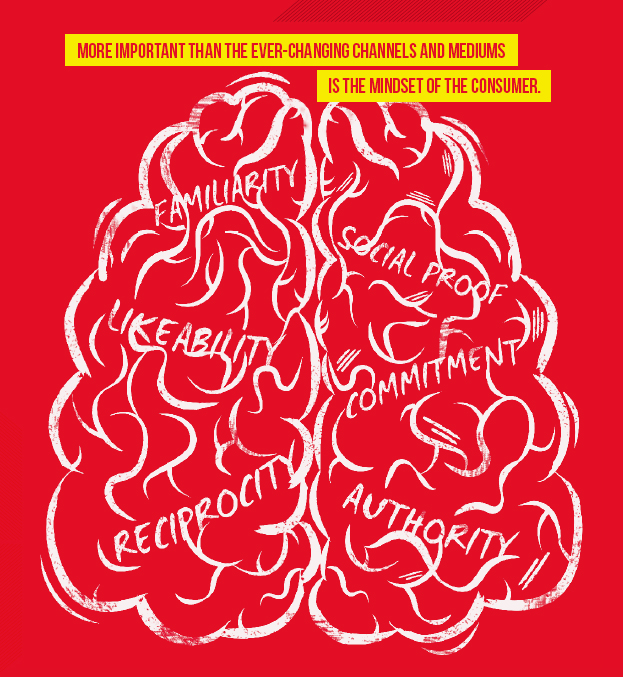
Familiarity
Building from the old-school goal of “awareness”, the expectation has shifted from just recall to a more personal connection: familiarity. The more times a consumer sees your message, the better. But the more they connect with the message, the more recall turns into caring for the product or brand.
Reciprocity
Beyond just telling consumers what they should feel or want, we should show them why they should purchase and interact with our brand. Brands, such as Toms, have capitalized on this mindset in an honest and authentic way – the philosophy of give, give, get. This doesn’t have to mean giving them discounts or coupons; it could be educational content like recipes or savings tips. The more you give utility and value, the more you will get from consumers.
Commitment
In the past, it was all about the “sale” and that first moment of truth – where a consumer is standing in the store aisle selecting which product or brand to purchase. Now there are many levels of commitment, from small pledges and comments to large commitments like an actual purchase. Each combination of these commitments builds that trust and fosters the relationship. The more people feel they have made a commitment to a brand, the more they feel obligated to fulfill their end of the agreement.
Social Proof
People trust people, not brands. Previously, it was all about expert reviews. Now, we as consumers look to other consumers for honest comments and reviews of the products and services we consume. Amazon has exploded with reviews and referrals based on this very mindset. We trust our friends, family and other consumers. Social proof is an endorsement. Activating advocates is imperative to solidify our credibility.
Likability
Fear tactics have been used successfully, but consumers want to like brands. They want you to be engaging, positive and helpful. For example, Dove focusing on self-esteem creates intense connection with the brand in a positive and engaging way. Consumers like the brand for the approach, and they not only recall messages and advertisements, they engage and share.
Authority
As the Internet has opened our world to real-time reports of anything and everything, building trust and credibility has become difficult for some brands. Creating authority in your industry requires transparency and education. Explaining what is important, why it is important and allowing consumers to see it unfold will build your brand’s authority, but, more importantly, it will build trust with your loyal consumers.
We must take from our past of reach, frequency and controlled messages and evolve. We must build relationships with our consumers – relationships based on generating interest, discovery and engagement. As we set up integrated campaigns, we must exceed these new expectations. If we keep these mindsets as objectives, we can truly connect with our consumers and convert them to brand advocates. Activate and facilitate conversations, slowly building lasting relationships that are independent of channels, campaigns and messages.
The 6 Integrated Mindsets are referenced in Dr. Robert Cialdini’s book “Influence: The Psychology of Persuasion”.
February 12th, 2016
Mobile or Die
When Apple’s first iPhone was announced in what is a now a seemingly distant summer of 2007, we entered a new era of mobile computing. A 3.5-inch (large-for-its-time) screen let users access and experience content on their phones in an entirely novel way – touching it. A method of input so natural that today we take it for granted. As the years went on and the ecosystem grew with the market, the hot mobile experience du jour did, as well. First, there were dedicated mobile sites, then (and still) apps, and now, here in 2015, we find ourselves with a trend that has arguably transcended to convention: responsive Web design.
Responsive design is the name given to a programming technique that allows your site to automatically adjust its layout to one best suited for the device you’re on. On a computer? The site fills the screen. On your phone? The site adjusts down to size – in a way that is still user-friendly. If you’ve used the Internet on your phone at all in the last two years, there’s almost no chance you haven’t used a responsive site.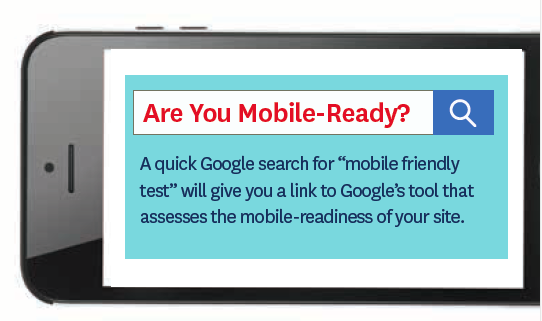 The idea makes so much sense. Why maintain multiple websites when I can maintain one? Responsive is also attractive in that an existing site can be retrofitted to be mobile-optimized without needing to redo the backend (and all the headache that can come with it).
The idea makes so much sense. Why maintain multiple websites when I can maintain one? Responsive is also attractive in that an existing site can be retrofitted to be mobile-optimized without needing to redo the backend (and all the headache that can come with it).
For the last few years, mobile optimization has been encouraged, but it was often hard to justify as a requirement. After all, people could find you in their searches just fine. Worst case was they may have to pinch and zoom around your site. As of April 2015, however, the worst case for not being mobile-optimized is your potential audience won’t even get a chance to see your website – because you will no longer appear (as prominently) in organic search results. Google made the decision to give mobile-optimized sites preferred ranking over non-mobile peers. … If you’re sweating about your site right now, don’t worry; you aren’t alone. This “mobile preference” is projected to affect the rankings of approximately 40 percent of the websites Google has indexed.
In this one outwardly simple change to how Google ranks websites, they have sounded a very clear decree. The mobile Web isn’t a trend or fad; its here to stay. To be digitally competitive, you have to be mobile-optimized, and responsive design is a great means to this end – but not the only one. Dedicated mobile websites are by no means dead and are in use on prominent Web presences. Neither is right or wrong, just a different tool, depending on the job. This being said, using responsive design for mobile optimization has become the defacto standard. A dedicated mobile site should only be considered if there are significant technical reasons why responsive would be neither possible nor practical.
Fifteen years ago, after we collectively got over worrying about Y2K, people actually debated whether the Internet was a fad or not. Today, nearly half the world’s population has access to the Internet – that’s a 741.0 percent increase over the same time. In the U.S. in particular, nearly everyone has access to the Internet (9 out of 10) – and 60 percent of the time they are accessing it through their phones. The desktop experience, of course, remains relevant, but mobile usage has reached a threshold that is too great to ignore.
If your business isn’t currently offering your mobile users an optimized browsing experience, it is time to start planning to offer them one. If you don’t, by this time next year, you might not have a mobile audience to be worrying about.
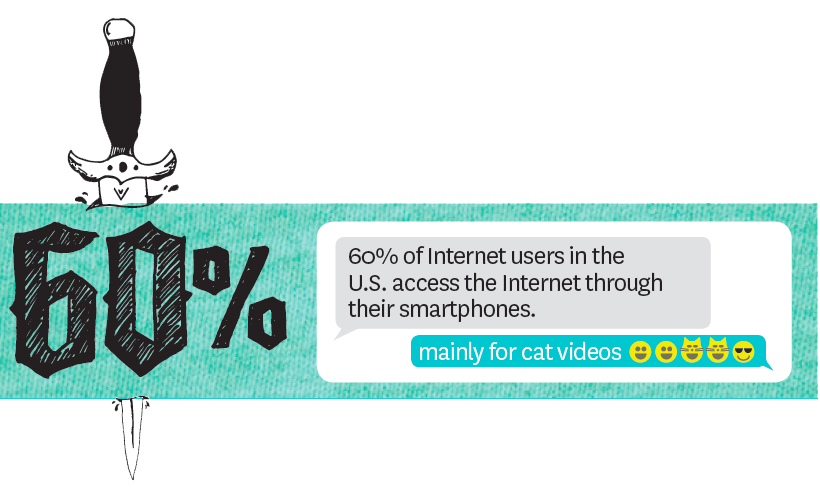
February 12th, 2016
Back to Basics
The four fundamental rules of advertising – then and now.
AMC’s “Mad Men” has come to a close, but our fasciation with the era – known as the Creative Revolution in advertising – remains.
As a fan of the show, it’s easy to marvel at how antiquated some of the ideas and practices seem. Women in power were a novelty in the Mad Men era; today, I work for a 100% woman-owned agency. The show’s Sterling Cooper and other ad agencies earned their incomes from 15% media commissions; today, most of our clients are fee-based, or, in a few progressive cases, performance-based. Don Draper dismisses research; today’s creative professionals relish it.
But when you step back, the fundamentals of advertising haven’t really changed at all.
In this current advertising era, there seems to be a mad rush to get to the new and dismiss the old. We’re always trying to chase the bright, shiny new object. And because of that, we tend to lose sight on the cornerstone of what makes this industry work. So here are four basic fundamentals of advertising that worked in the past and you should still follow today.
Understand your audience.
 When it comes to this fundamental, I say look to the patron of advertising for guidance: David Ogilvy. There are two Ogilvy rules of thumb you should always remember. The first is to give your audience the credit they deserve. Ogilvy says, “The consumer isn’t a moron; she is your wife.” A little sexist sounding now, admittedly, but the sentiment is still there. To be successful in this industry, respecting the consumer’s intelligence is a must. The second rule of thumb is to do your homework. Ogilvy believed that “if you don’t know who you’re writing for, you’ll just be faking it, and that will lead to more problems than you can imagine.” So get to know your audience – understand how they think and what they need.
When it comes to this fundamental, I say look to the patron of advertising for guidance: David Ogilvy. There are two Ogilvy rules of thumb you should always remember. The first is to give your audience the credit they deserve. Ogilvy says, “The consumer isn’t a moron; she is your wife.” A little sexist sounding now, admittedly, but the sentiment is still there. To be successful in this industry, respecting the consumer’s intelligence is a must. The second rule of thumb is to do your homework. Ogilvy believed that “if you don’t know who you’re writing for, you’ll just be faking it, and that will lead to more problems than you can imagine.” So get to know your audience – understand how they think and what they need.
Speak the truth.
The sad truth is, people don’t trust advertising anymore. In 1912, the founders of McCann Erickson started their agency on the motto “Truth Well Told” – a credo that, if applied appropriately, can still lead to some of the most effective advertising. Take Bill Bernbach’s iconic “Think Small” campaign for example, where Volkswagen took a seemingly negative product (a “small” vehicle) and paralleled it to positives (“small insurance” and a “small repair bill” and so on). Or the Avis “We Try Harder” campaign, where they took the simple truth of being ranked second in the industry and turned that into a reason (or rather, a vow) to try harder for the consumer. Both were successfully truthful campaigns, and both are approaches that can still work today. Remember, it’s okay to have a little humility and self-deprecation. It’s disarming. So, rather than trying to fabricate something, highlight the truths and relate those to the audience and their needs/desires.
(or rather, a vow) to try harder for the consumer. Both were successfully truthful campaigns, and both are approaches that can still work today. Remember, it’s okay to have a little humility and self-deprecation. It’s disarming. So, rather than trying to fabricate something, highlight the truths and relate those to the audience and their needs/desires.
Make things connect.
Don’t yell at people. And don’t talk over people’s heads. I turn to Ogilvy’s advice yet again: “Write the way you talk. Naturally.” Let me give you an example. Imagine walking into a car dealership and the dealer says to you in a slow, commanding voice, “Speed. Power. Performance. That’s what you’re looking for in an experience.” You’d think he was nuts. Because that’s not how people talk. The same goes for your advertising. Talk to them directly. And remember the first two fundamental rules while you’re at it: connect with them on a level that includes respect and honesty.
Be relevant.
At its core, advertising is about gaining attention and interest of an otherwise disinterested audience. How many times have you heard people say, “Nobody reads ads”? Well Howard Gossage, an advertising icon during the “Mad Men” era, said it best, “People read what interests them, and sometimes that’s an ad.” If what you’re putting out there is relevant to someone, they’ll pay attention. It’s just that simple. But that’s why it’s so important to make someone curious enough to stay engaged – and why knowing your audience’s needs and wants from the get-go will help you tremendously in the long run.
Just because it may have seemed groundbreaking in the past and old hat now, doesn’t mean the basic fundamentals of advertising should be forgotten. There’s so much gold there that we’re dismissing. It’s still relevant today. In fact, it’s pertinent. So take it from the greats and get back to the basics.
February 12th, 2016
It's a Two-Way Street
When I first started in this business some 30 years ago, we spent a lot of time in upfront planning and strategy to understand consumer needs, wants and behavior, but once the campaign launched, 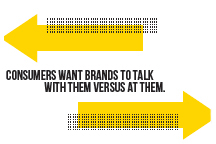 it was pretty much ‘set it and forget it.’ The tools of that time were fewer and they were one way. So we marketers formed our messages, and it was pretty much a monologue. Today, not so much. Transition from monologue to dialogue.
it was pretty much ‘set it and forget it.’ The tools of that time were fewer and they were one way. So we marketers formed our messages, and it was pretty much a monologue. Today, not so much. Transition from monologue to dialogue.
Not only is there significantly more media fragmentation, more access to data, and 100 times the number of options to reach consumers, but also (and most importantly) the Internet has shifted the power dynamic from marketers to consumers – specifically Web 2.0.
With just a click of a button, consumers can access data from around the world to gain meaningful insights about companies and their products. They can compare products, find lower prices, read reviews and even communicate with other users about product quality and buyer satisfaction.

Iterative planning and execution have become the norm.
While we still do smart planning with a lot better tools at our disposal, the launch of a campaign today is just the beginning. As marketers, we need to monitor conversations, track sentiment, gauge behaviors and assess ongoing performance. And we must optimize or change our efforts on the fly. Overall, each marketing plan and execution has become more iterative.
Beware: consumers can easily disengage.
Contrary to what some would have you believe, traditional media, like TV, radio and print, are not dead. But you can no longer count on traditional advertising alone to capture and keep attention. You need to be where your audience is, with a compelling message that sparks conversation and engagement. And it’s not easy to engage more deeply with consumers when they have the power to so easily disengage.
Find the right place, time and message.
Being at the ‘right place at the right time with the right message’ has always been the goal of marketers. And today, with the wealth of data at our fingertips, we have the ability to do just that. When consumers make brand contact, they seek true one-to-one engagement versus simply a barrage of one-way marketing messages. Consumers want brands to talk with them versus at them. They seek a variety of messaging through a variety of channels that paint a consistent picture of the brand experience you offer.
Consumers can sniff out manipulation a mile away.
Consumers have become increasingly resistant to feeling manipulated, and they will make their views widely known. They will quickly sniff you out if they believe you are using them only for your own benefit, or if something is not authentic. Case in point, recently Starbucks launched the #RaceTogether initiative, which was the company’s diversity and racial equality campaign. While the intent may have been good, the execution was not. And after just one week, and a ton of negative backlash, the effort was pulled.
The more things change, the more the key marketing principles endure.
While the tools of the trade have changed dramatically, and technology will be ever-evolving, the fact is that the basic tenants of marketing hold constant against the odds of change.
Information overload. We need to work hard to give relevant meaning and appropriate context in order to retain the attention of our audience.
 People buy a feeling. The best branding inseparably integrates itself with the consumer’s lifestyle.
People buy a feeling. The best branding inseparably integrates itself with the consumer’s lifestyle.
Existing customers are pure gold. When you engage buyers in the right manner to remind them why they spent money with you in the first place, your company stands an excellent chance of earning a repeat sale.
Creativity is king. Being truly creative is the only way to stand out from the crowd.
Sound marketing planning and strategy helps you succeed. Information is powerful, and building a good marketing strategy starts with understanding the external factors that will affect your business.
February 12th, 2016
Think Socially
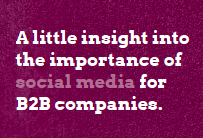 I’ve spent years developing marketing campaigns for B2B audiences in a variety of industries. In recent years, as social media in particular has become an increasingly important part of the mainstream marketing mix, I’ve noticed a reluctance on behalf of many B2B marketers to embrace this channel. The reasons tend to circle around the belief stated by a major, international brand marketer I knew, that “our B2B customers aren’t on social media.”
I’ve spent years developing marketing campaigns for B2B audiences in a variety of industries. In recent years, as social media in particular has become an increasingly important part of the mainstream marketing mix, I’ve noticed a reluctance on behalf of many B2B marketers to embrace this channel. The reasons tend to circle around the belief stated by a major, international brand marketer I knew, that “our B2B customers aren’t on social media.”
It’s my belief that this reasoning is based more on fear and ignorance than any reality. Go to any B2B industry trade show and watch the people walking the show floor – like everyone else everywhere else, they have their noses stuck in their smartphones. Traveling to see a customer? Checking in at the factory or distribution center? The first thing that happens when that plane hits the ground is everyone – tourists and business people alike – turn on their phones and get connected.
 Unlike consumer industries or tech startups, B2B is a slower-moving beast, less subject to trends. But guess what? With apologies to a comment Bill Gates once made, the Internet isn’t a fad. Smartphones aren’t just for kids. It’s time to get on board or get left behind.
Unlike consumer industries or tech startups, B2B is a slower-moving beast, less subject to trends. But guess what? With apologies to a comment Bill Gates once made, the Internet isn’t a fad. Smartphones aren’t just for kids. It’s time to get on board or get left behind.
One of the challenges is that there is no proven set of tactics to follow. 25 years ago, you ran print ads in relevant trade pubs, maybe did some targeted direct mail (preferably something expensive and flashy), made a nice brochure and called it a day.
It’s different today. Businesses trying to connect with businesses have to choose to either wade into the ambiguity and be a leader (and suffer the inherent missteps that come with blazing new trails) or wait for someone else to pave the way and then follow. And while it’s intuitive to be cautious, it’s more expensive to play catch-up.
Remember this: people are people, whether they are buying for business or buying for personal consumption. The same motivations apply – we make decisions based on emotion and then seek rational support for our actions. And we seek that information the same way – by going online, visiting websites, searching social media for opinions, and gathering all the data we can, from whenever we can. Before that customer ever reaches out to your sales rep, or walks into your distribution center, they’ve been online – at home, in the car (not while driving, of course), from the TSA line – anywhere and everywhere.
The question is, will you be there when they come looking?


